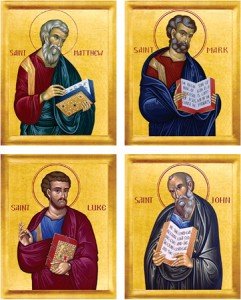 I have, in this article, been attempting to present the various ideas that biblical scholars have about the Synoptic problem. The problem is this: why are there similarities and, of course, differences between the Gospels of Matthew, Mark and Luke. I have presented two solutions so far, namely that Matthew is the source for Mark and Luke OR Mark is the source for Matthew and Luke. These theories postulate a literary interdependence. These theories, however, suppose that two of the Synoptics depend on the third, in other words on an existing Gospel. There is, however, other theories. The other theories depend on the reconstructed, hypothetical source that is no longer extant and not the same as any canonical Gospel. Sometimes these theories are thought to supplant previous explanations of the Synoptic Problem. At other times they are combined with one of the explanations already given with dependence on oral tradition or with dependence on Mark.
I have, in this article, been attempting to present the various ideas that biblical scholars have about the Synoptic problem. The problem is this: why are there similarities and, of course, differences between the Gospels of Matthew, Mark and Luke. I have presented two solutions so far, namely that Matthew is the source for Mark and Luke OR Mark is the source for Matthew and Luke. These theories postulate a literary interdependence. These theories, however, suppose that two of the Synoptics depend on the third, in other words on an existing Gospel. There is, however, other theories. The other theories depend on the reconstructed, hypothetical source that is no longer extant and not the same as any canonical Gospel. Sometimes these theories are thought to supplant previous explanations of the Synoptic Problem. At other times they are combined with one of the explanations already given with dependence on oral tradition or with dependence on Mark.
One of these theories is called the Single Document as basis for a three-fold tradition. They theory is known as the Primitive-Gospel Solution. It suggests that the Synoptics all drew their material from a primitive Aram Gospel that has been lost. This theory suggests that each Synoptic Gospel is quite independent of one another. They would all have drawn from a document that contained the entire life of Christ. This document was composed in Aram at an early date and subsequently translated into Greek and revised a number of times. The Synoptics would have made use of these revisions when composing their Gospels.
This theory, while simply and yet progressively more complex, has been unsuccessful and has been abandoned by scholars. There would certainly have been greater uniformity among the Gospels in content, arrangement and language if the theory were fact. There was a positive value to the theory. It paved the way for the recognition that our canonical Gospels represent the culmination of a literary process, and the supposition of a common source for Matthew and Luke was the first insight into the proposal of a “sayings” source or document. In more recent times the Gospel of Thomas was found and published which contains a collection of Jesus “sayings”.
There are two other theories in this category of a common source outside of the three Gospels known as the Synoptic Gospels. When this is all considered, I think it makes a very fundamentalist approach difficult!
